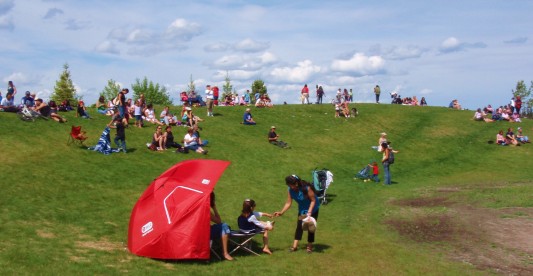Our first full day in Whitehorse, Yukon Territory, we walked to check out the celebration of First Nations Day in a city park. There was free salmon and bannock for the hungry and some decidedly interesting people watching. Sometimes it’s hard to tell who’s of First Nation descent and who’s not. The white devils have been here a long time and the natives have been welcoming.
A fun example of the cultural mixing here was the jig contest. Now, I’ve always thought of the jig, danced to a fast fiddle, as an Anglo-Saxon tradition: Irish, Scottish, French, but here it’s a local tradition, with most of the dancers of First Nations descent, with plenty of mixed and white faces giving it a go. Oh, by the way, the really really excellent fiddler seemed to be from the orient. Go figure.


My favorite dancer was an older lady who jigged her moccasins a bit slower than some, but in perfect time, and with a style the youngsters watched with rapt attention.
First Nations Day is celebrated on the Summer Solstice, June 21, just a week or so before Canada Day. When you live in the North, you notice and appreciate the longest day of the year, because you can remember the near total darkness of the shortest day, and coldest months.
That night I was up until sunset, around 11:20, and when I awoke around 3:00 noticed the sunrise, long past, had taken place just a few degrees to the east of sunset. The sun carves a giant parabola this day in Whitehorse. I’d be curious to see sun hug the southern horizon briefly each day in winter, but not curious enough to face a cold dark winter.
We walked a beautiful five kilometer trail beside the Yukon River, enjoyed the full summer bloom of wild roses, listened to the birds and exchanged pleasantries with locals. Whitehorse is a very small town by most standards, but seems to have a vitality not found in similar sized towns in lower Canada or the U.S. Perhaps it is the length and severity of winter that sharpens appreciation of their short summer, but it seems to be more complicated. I’d be willing to be they have as much fun in their dark winter as they do in their bright summer.
The relations between First Nations people and pioneers (people who come from the south are still pioneers as far as I’m concerned) seem better than some places we’ve been in Canada, and the U.S. We stopped here mostly to catch up on housekeeping chores, but will end up staying several days to enjoy the town and surrounds, and the people.

Claire Rogers writes on cross-cultural adventure drawn from her travels across the Silk Road from Beijing to Istanbul, around Australia and of course, through Iceland–all by bike.
She’s currently traveling by tandem with her husband Bob, through southwest China, Laos, Vietnam, Cambodia and Thailand. Check out NewBohemians.net for more information on their travels.








